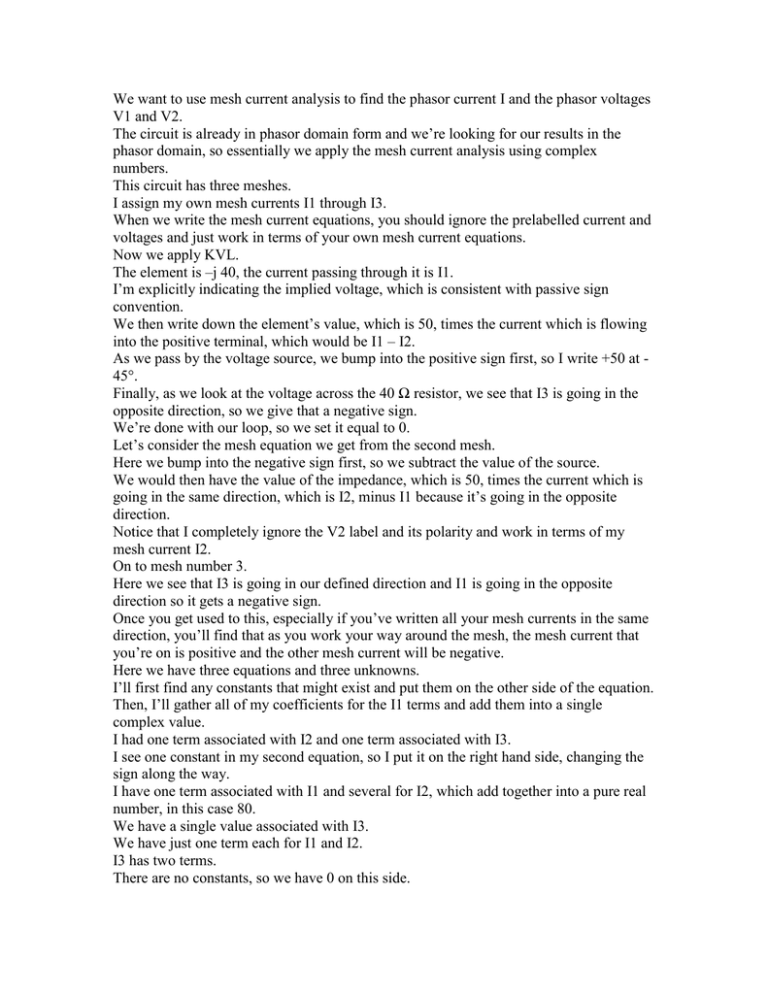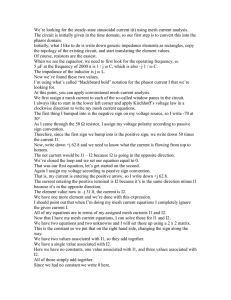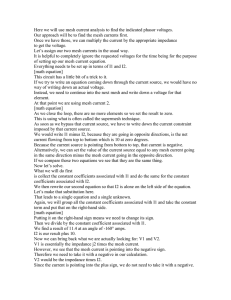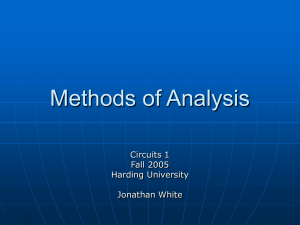We want to use mesh current analysis to find the... V1 and V2.
advertisement

We want to use mesh current analysis to find the phasor current I and the phasor voltages V1 and V2. The circuit is already in phasor domain form and we’re looking for our results in the phasor domain, so essentially we apply the mesh current analysis using complex numbers. This circuit has three meshes. I assign my own mesh currents I1 through I3. When we write the mesh current equations, you should ignore the prelabelled current and voltages and just work in terms of your own mesh current equations. Now we apply KVL. The element is –j 40, the current passing through it is I1. I’m explicitly indicating the implied voltage, which is consistent with passive sign convention. We then write down the element’s value, which is 50, times the current which is flowing into the positive terminal, which would be I1 – I2. As we pass by the voltage source, we bump into the positive sign first, so I write +50 at 45°. Finally, as we look at the voltage across the 40 Ω resistor, we see that I3 is going in the opposite direction, so we give that a negative sign. We’re done with our loop, so we set it equal to 0. Let’s consider the mesh equation we get from the second mesh. Here we bump into the negative sign first, so we subtract the value of the source. We would then have the value of the impedance, which is 50, times the current which is going in the same direction, which is I2, minus I1 because it’s going in the opposite direction. Notice that I completely ignore the V2 label and its polarity and work in terms of my mesh current I2. On to mesh number 3. Here we see that I3 is going in our defined direction and I1 is going in the opposite direction so it gets a negative sign. Once you get used to this, especially if you’ve written all your mesh currents in the same direction, you’ll find that as you work your way around the mesh, the mesh current that you’re on is positive and the other mesh current will be negative. Here we have three equations and three unknowns. I’ll first find any constants that might exist and put them on the other side of the equation. Then, I’ll gather all of my coefficients for the I1 terms and add them into a single complex value. I had one term associated with I2 and one term associated with I3. I see one constant in my second equation, so I put it on the right hand side, changing the sign along the way. I have one term associated with I1 and several for I2, which add together into a pure real number, in this case 80. We have a single value associated with I3. We have just one term each for I1 and I2. I3 has two terms. There are no constants, so we have 0 on this side. At this point, you can use your favourite technique for solving a system of three equations and three unknowns. We have our three mesh currents figured out. Lastly, we want to find the desired values in terms of our mesh currents. I is I1, because they’re in the same direction. V2 will have a negative sign because I2 is in the opposite direction of what we would have needed for passive sign convention, so it’s –j 50 times I2. In this case, since I3 is going in the correct direction for passive sign convention, that is, entering the positive terminal, in this case we just write down j 75 times I3. These then are the three quantities we were looking for.









